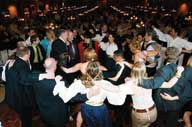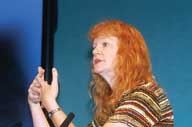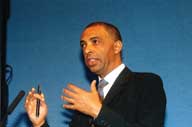 Bill Harvey enjoys the high life at the Bausch & Lomb Global Symposium held recently in Athens
Bill Harvey enjoys the high life at the Bausch & Lomb Global Symposium held recently in Athens
In introducing this year's Bausch and Lomb Global Symposium on Vision Correction, Alan Farnsworth (senior vice-president and president of Europe, Middle East and Africa) referred to the very first such meeting which had taken place back in 1983 and which had originally been known as the European Research Group. The packed programme reflected this, containing everything from the very cutting edge of research to a jaw-dropping presentation with Harley Davidsons.
meeting which had taken place back in 1983 and which had originally been known as the European Research Group. The packed programme reflected this, containing everything from the very cutting edge of research to a jaw-dropping presentation with Harley Davidsons.
Turning Knowledge into Inspiration
Each session was moderated by a well known figure in eye care. Professor Des Fonn (Waterloo) introduced the first session which included Dr Karla Zadnik (Ohio) reviewing the recent research flurry surrounding myopia and the consequences of its increasing incidence. Only accounting for 25 per cent of the US refractive error, myopia was epidemic in many Asian nations, approaching 90 per cent penetrance in Taiwan for example.  She reviewed the various classifications used for myopia which can influence how some epidemiological statistics are analysed. Grosvenor had proposed categorisation by age; congenital (<6 years), youth onset (6 to 20 years), early adult (up to 45 years) and late onset. Goldschmitt had instead gone for a simple dichotomy into benign (less than -6DS with normal fundus) and pathological (greater than 6DS with fundus changes, while Sorsby had used 4DS as a watershed value. In reviewing all the studies into risk factors, Zadnik described the familiar risks (having two myopic parents represented a 6.4x risk increase, for example) but surprisingly implied that sports related activities showed a relative risk decrease of 0.92X which she felt was significant. Whether this was cause or effect (simply that less well sighted might not indulge in more studious activities rather than the activities themselves causing the myopia) is still somewhat controversial.
She reviewed the various classifications used for myopia which can influence how some epidemiological statistics are analysed. Grosvenor had proposed categorisation by age; congenital (<6 years), youth onset (6 to 20 years), early adult (up to 45 years) and late onset. Goldschmitt had instead gone for a simple dichotomy into benign (less than -6DS with normal fundus) and pathological (greater than 6DS with fundus changes, while Sorsby had used 4DS as a watershed value. In reviewing all the studies into risk factors, Zadnik described the familiar risks (having two myopic parents represented a 6.4x risk increase, for example) but surprisingly implied that sports related activities showed a relative risk decrease of 0.92X which she felt was significant. Whether this was cause or effect (simply that less well sighted might not indulge in more studious activities rather than the activities themselves causing the myopia) is still somewhat controversial.
Professor Fonn presented some of his well known findings on silicone hydrogel material lenses and how important they have been in reducing the hypoxic risk. He explained how presently there were 110 million lens wearers worldwide of whom about 9 per cent wore silicone hydrogels. By the year 2020 there were likely to be 2.5 billion myopes. This alone was incentive to continue eye correction research. Eric Papas (New South Wales) began his excellent presentation by confessing to a Greek ancestry and put his full surname (of which Papas gave only two of the actual seven syllables) on screen to a round of applause. His main topic of concern was the discomfort of contact lenses contributing to one third of all new lens fits eventually dropping out of lens wear. This obviously has significant chair time and cost implications. What was interesting was the finding that spectacle wearers also feel discomfort, and are twice as likely to suffer dryness symptoms than non-wearers, though why this might be so was not explained.
Eric Papas (New South Wales) began his excellent presentation by confessing to a Greek ancestry and put his full surname (of which Papas gave only two of the actual seven syllables) on screen to a round of applause. His main topic of concern was the discomfort of contact lenses contributing to one third of all new lens fits eventually dropping out of lens wear. This obviously has significant chair time and cost implications. What was interesting was the finding that spectacle wearers also feel discomfort, and are twice as likely to suffer dryness symptoms than non-wearers, though why this might be so was not explained.
He also noted that discomfort was linked to blur and precise vision correction reduced complaints of discomfort. He then gave an impressive summary of sensory receptors on the ocular surface which paid tribute to an excellent paper by Muller et al (Experimental Eye Research, 76 (2003) pp521-542). Corneal nerves adopt a 'swirly' plexus arrangement over the stroma and beneath the basal layer with offshoots passing up through the epithelium. Receptors comprised of 20 per cent responding to mechanical influence, 10 per cent to temperature and the remaining being polymodal responding to pressure, temperature and pH changes. A lovely Heath Robinson touch was displayed by the adapted AO NCT as a gas jet aesthesiometer which was found more useful than the nylon filament apparatus some readers may remember.
Dr Richard Puechner (private practice, Germany) described a five-year follow-up of 30-day continuous wear silicone hydrogel users and noted he saw no adverse responses. This was in conflict with most of the later speakers and something he could not explain. Many delegates were sceptical of his findings.
Dr Phil Morgan (Manchester) was clearly getting ready for the Eurovision theme at the forthcoming BCLA (the real event is coincidentally in Athens). He reviewed the various wearing habits of countries around the world, introducing each company profile with a 'is anyone here from....?' He even cheekily asked 'Is any one here from the States, or at least anyone who would admit to it?'
The well known trends, such as the UK love of daily disposables, the Japanese and Dutch love of RGPs and the embracing of continuous wear in Norway were all mentioned. The move towards silicone hydrogels but with a much more flexible approach to wear was the dominant pattern of growth and this was set to continue, he predicted.
Register now to continue reading
Thank you for visiting Optician Online. Register now to access up to 10 news and opinion articles a month.
Register
Already have an account? Sign in here
